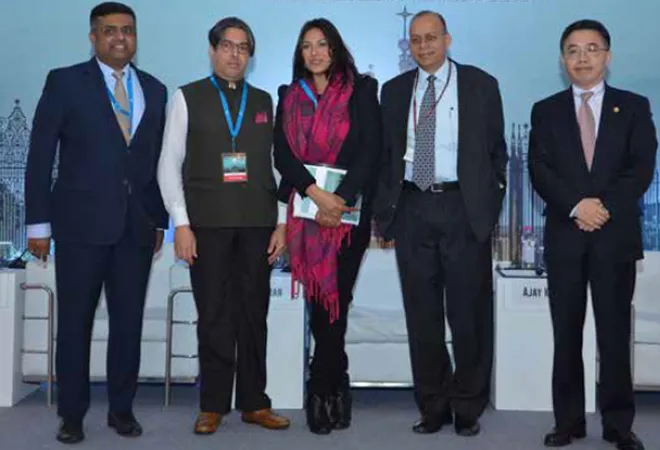
A historical ordinance issued by the Government of India to demonetise old currency notes of higher denominations on 8 November 2016 was not just a strike on black money hoarders but also an attempt to transform India into a less-cash economy by promoting digital payments. Moderated by Bloomberg TV India, Consulting Editor Fatima Karan, the panel on “Bits and Bytes: Reaching Money to the Bottom of the Pyramid” provided a forum to discuss the impact of demonetisation on Digital India, an initiative of the government that aims to build a digitally empowered society by focusing on three key areas — infrastructure as a utility, governance and services on demand, and digital empowerment of citizens.
Post-demonetisation, use of various segments of digital payments such as mobile banking, payment through point of sale, m-wallets, and electronic fund transfers, among others, experienced a significant growth. However, this scenario was limited to a period of two months. Once sufficient currency began to flow back into the economy, the use of digital platforms for transactions declined once again. According to the Reserve Bank of India’s Payment and Settlement System, the volume of digital payments grew by 46.3 per cent between November and December 2016, and then dropped by 7.1 per cent in January 2017.
Digital payments were used extensively immediately after demonetisation due to lack of other options. Consequently, use of debit and credit cards at point of sale increased by 75 per cent and 18 per cent respectively. However, use of cards at ATMs increased only marginally during this same period, owing to the unavailability of sufficient cash in the machines. Prepaid Payment Instruments (PPIs), including m-wallets, PPI cards and paper vouchers, have meanwhile continued to see a rise in user base since November 2016. This is due to several government initiatives and schemes launched or promoted under the Digital India initiative. These include the Aadhaar identity platform, Bharat Interface for Money (BHIM), Unified Payment Interface, Direct Benefit Transfers, e-NAM and the Geographic Information System.
India is undergoing a digital revolution in its payment landscape. This transformation is driven predominantly by improvements in digital infrastructure, comprising widespread internet connectivity, creating digital identity through Aadhaar, increasing mobile and smartphone penetration and rising digitisation of banking transactions. Today, India has over 1 billion mobile phone subscriptions, and 0.2 billion smartphone users. With internet connectivity expanding rapidly, the number of internet users across rural and urban areas is expected to grow from 300 million in 2015 to about 650 million by 2020.
The foremost step towards a digital payment economy is to provide a digital identity to every individual in the country, which was carried out through Aadhaar. Another prerequisite is greater financial inclusion, which has been achieved through the Pradhan Mantri Jan Dhan Yojana. And a third but integral step is to provide an affordable interface to link digital identities with bank accounts to ensure easy payment and transfer of funds. The JAM trinity, therefore, has been one of the most essential measures taken by the government in the ongoing digital payments revolution.
In the longer run, digitisation and formalisation of the economy are going to be the most important medium to long-run benefits of demonetisations. — Vivek Dehejia, Resident Senior Fellow, IDFC Institute, India
Having established that, despite numerous government efforts to popularise digital transactions, India continues to be a cash-dependent economy. This is because the transformation to a less-cash society requires attitudinal and behavioural changes, which is a long-term process. Customers in India resist adopting digital payments due to fear of insecure transactions while merchants prefer cash payments to avoid taxes. To tackle these, the government has started incentivising customers, merchants and service providers through schemes such as hourly gala lotteries, cash backs, discounts and tax benefits to encourage use of digital payments. Additionally, the government is also organising digital literacy programmes to create awareness about the benefits of digital payments, especially among lower-income groups. These programmes are essential for achieving universal financial inclusion and enabling money to reach the bottom of the pyramid. India has thus a lot to learn from experiences of developing economies such as Kenya, China and Sweden in the digital space. Despite being a low-income economy, Kenya has been successful in transitioning to mobile payments at a mass scale by capitalising on high mobile penetration, robust mobile networks and low-cost transaction systems. China, too, has created similar online payment systems, known as Alipay and WeChat Pay, to overcome major barriers of lack of trust between buyers and sellers, and low credit card penetration. Taking a cue from them, Indian startup firm Paytm has replicated the QR code services, popularly used by the Chinese, for digital payments. However, a major barrier in India has been the lack of interoperability of QR code services between networks. This was considerably overcome earlier this year by Bharat QR, an integrated payment system that uses mobile phones to pay through debit/credit cards by scanning a code at the merchant’s place. As of now, RuPay, MasterCard, VISA and American Express cards can be linked to pay through Bharat QR.
What India needs right now is a well-connected, secure and interoperable digital ecosystem to accelerate large-scale adoption of digital payments. According to World Bank estimates, India can save 1 per cent of its gross domestic product annually from digitising payments. This makes it imperative for India to provide incentives to customers, merchants and service providers to expedite adoption of digital payments.
The views expressed above belong to the author(s). ORF research and analyses now available on Telegram! Click here to access our curated content — blogs, longforms and interviews.




 PREV
PREV

